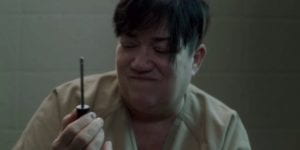For this blog entry, I will be focusing on the cinematography of the episode “Imaginary Enemies”. In this episode, there are a lot of major plot twists and surprises. Piper is struggling especially adjusting to prison life, she seems to be at a low point, hallucinating, but is pulling through day by day. We get a glimpse of Piper’s new roommate Mrs. Claudette and her backstory of how she got here. At first, Piper was afraid of Mrs. Claudette as a result of her serious demeanor and brevity to call out whoever she likes. Mrs.Claudette is well-known for her seemingly wise personality and courage as a person. Piper’s issue with the screwdriver and constant memory loss suggests her mental health may continue to decline and suffer as the show goes on. One of the inmates Mercy has gotten an appeal accepted for her case and was released at the end of the episode, creating a flush of emotions and change throughout this entire plot. This helped the prisoners see that there is possible hope in their cases, and to never give up.
With the cinematography, scenes in the prison were shot pretty blandly. There are numerous long takes when focusing on a specific person’s important commentary, likely shot to help viewers concentrate more on each individual’s traits and details they contribute to the overall plot. However, in the midst of sensitive scenes dealing with racism or stereotyping where the details aren’t as important to the whole plot, I noticed that there are much more quick cuts and switches to different parts of the environment.
A large detail noticed in this episode is the lighting of various scenes. In the prison scenes, the lighting was dull and it was clear enough to see items clearly and distinguish faces easily, yet it was obvious those scenes weren’t well-lit or anything like that. On the other hand, in the scenes where they throw it back to Mrs.Claudette’s past, the house present in the scene was extremely bright, and immediately lightened up the mood of the plot. Also, in Mercy’s farewell scene at the end of the episode, the lobby room was unusually more lit up than the other scenes in the prison. I believe the screenwriter intentionally did this to signify two different scenarios and that emphasize the fact that although all of these women are dangerous and potentially bad characters, the portrayal of these scenes reminded the viewers that the women had a previous happy life and the actions that led them into where they are right now(prison) are not necessarily just.

Boo with Piper’s stolen screwdriver

Comments are closed.